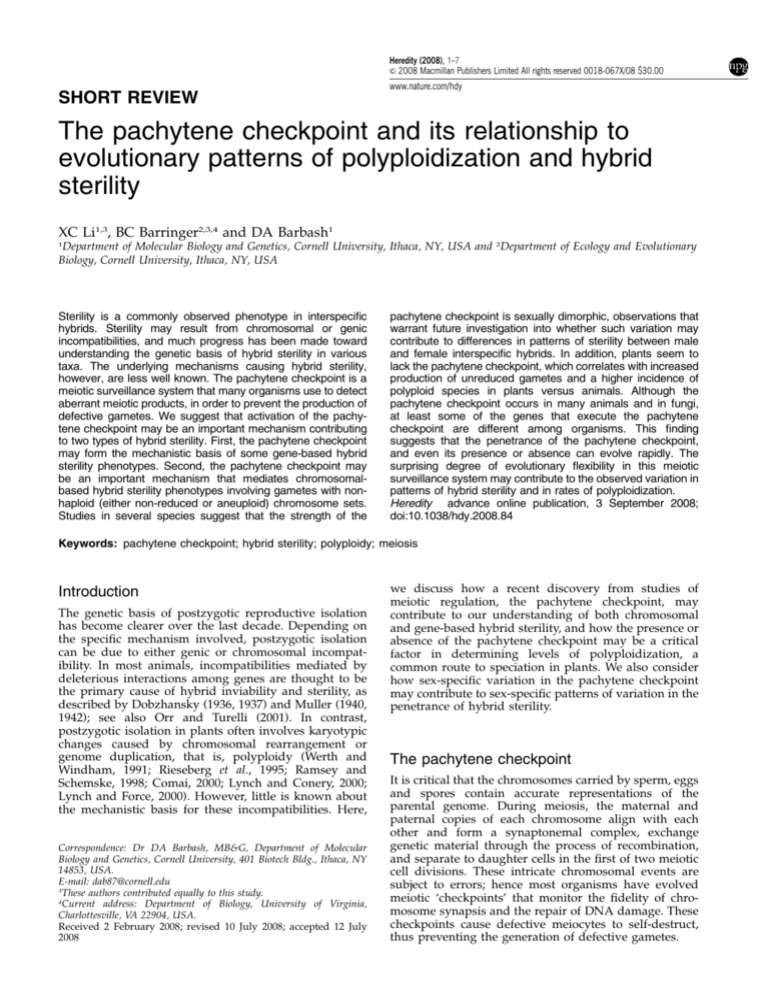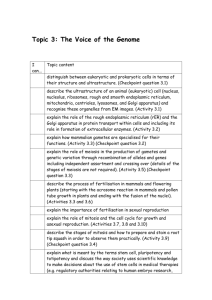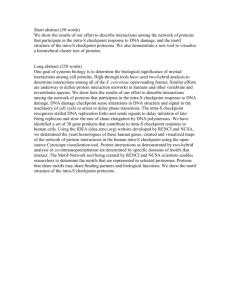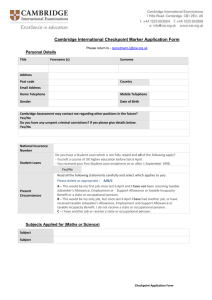
Heredity (2008), 1–7
& 2008 Macmillan Publishers Limited All rights reserved 0018-067X/08 $30.00
SHORT REVIEW
www.nature.com/hdy
The pachytene checkpoint and its relationship to
evolutionary patterns of polyploidization and hybrid
sterility
XC Li1,3, BC Barringer2,3,4 and DA Barbash1
1
Department of Molecular Biology and Genetics, Cornell University, Ithaca, NY, USA and 2Department of Ecology and Evolutionary
Biology, Cornell University, Ithaca, NY, USA
Sterility is a commonly observed phenotype in interspecific
hybrids. Sterility may result from chromosomal or genic
incompatibilities, and much progress has been made toward
understanding the genetic basis of hybrid sterility in various
taxa. The underlying mechanisms causing hybrid sterility,
however, are less well known. The pachytene checkpoint is a
meiotic surveillance system that many organisms use to detect
aberrant meiotic products, in order to prevent the production of
defective gametes. We suggest that activation of the pachytene checkpoint may be an important mechanism contributing
to two types of hybrid sterility. First, the pachytene checkpoint
may form the mechanistic basis of some gene-based hybrid
sterility phenotypes. Second, the pachytene checkpoint may
be an important mechanism that mediates chromosomalbased hybrid sterility phenotypes involving gametes with nonhaploid (either non-reduced or aneuploid) chromosome sets.
Studies in several species suggest that the strength of the
pachytene checkpoint is sexually dimorphic, observations that
warrant future investigation into whether such variation may
contribute to differences in patterns of sterility between male
and female interspecific hybrids. In addition, plants seem to
lack the pachytene checkpoint, which correlates with increased
production of unreduced gametes and a higher incidence of
polyploid species in plants versus animals. Although the
pachytene checkpoint occurs in many animals and in fungi,
at least some of the genes that execute the pachytene
checkpoint are different among organisms. This finding
suggests that the penetrance of the pachytene checkpoint,
and even its presence or absence can evolve rapidly. The
surprising degree of evolutionary flexibility in this meiotic
surveillance system may contribute to the observed variation in
patterns of hybrid sterility and in rates of polyploidization.
Heredity advance online publication, 3 September 2008;
doi:10.1038/hdy.2008.84
Keywords: pachytene checkpoint; hybrid sterility; polyploidy; meiosis
Introduction
The genetic basis of postzygotic reproductive isolation
has become clearer over the last decade. Depending on
the specific mechanism involved, postzygotic isolation
can be due to either genic or chromosomal incompatibility. In most animals, incompatibilities mediated by
deleterious interactions among genes are thought to be
the primary cause of hybrid inviability and sterility, as
described by Dobzhansky (1936, 1937) and Muller (1940,
1942); see also Orr and Turelli (2001). In contrast,
postzygotic isolation in plants often involves karyotypic
changes caused by chromosomal rearrangement or
genome duplication, that is, polyploidy (Werth and
Windham, 1991; Rieseberg et al., 1995; Ramsey and
Schemske, 1998; Comai, 2000; Lynch and Conery, 2000;
Lynch and Force, 2000). However, little is known about
the mechanistic basis for these incompatibilities. Here,
Correspondence: Dr DA Barbash, MB&G, Department of Molecular
Biology and Genetics, Cornell University, 401 Biotech Bldg., Ithaca, NY
14853, USA.
E-mail: dab87@cornell.edu
3
These authors contributed equally to this study.
4
Current address: Department of Biology, University of Virginia,
Charlottesville, VA 22904, USA.
Received 2 February 2008; revised 10 July 2008; accepted 12 July
2008
we discuss how a recent discovery from studies of
meiotic regulation, the pachytene checkpoint, may
contribute to our understanding of both chromosomal
and gene-based hybrid sterility, and how the presence or
absence of the pachytene checkpoint may be a critical
factor in determining levels of polyploidization, a
common route to speciation in plants. We also consider
how sex-specific variation in the pachytene checkpoint
may contribute to sex-specific patterns of variation in the
penetrance of hybrid sterility.
The pachytene checkpoint
It is critical that the chromosomes carried by sperm, eggs
and spores contain accurate representations of the
parental genome. During meiosis, the maternal and
paternal copies of each chromosome align with each
other and form a synaptonemal complex, exchange
genetic material through the process of recombination,
and separate to daughter cells in the first of two meiotic
cell divisions. These intricate chromosomal events are
subject to errors; hence most organisms have evolved
meiotic ‘checkpoints’ that monitor the fidelity of chromosome synapsis and the repair of DNA damage. These
checkpoints cause defective meiocytes to self-destruct,
thus preventing the generation of defective gametes.
The pachytene checkpoint
XC Li et al
2
Pachytene is the stage of meiotic prophase I where
chromosomes are completely aligned with their homologous partner, a process known as synapsis. In many
species, including Saccharomyces cerevisiae, Drosophila
melanogaster, Caenorhabditis elegans and mice, defects in
recombination and/or synapsis lead to arrest during the
pachytene stage, and arrested cells will eventually be
eliminated (Bishop et al., 1992; Sym et al., 1993; Edelmann
et al., 1996; McKee and Kleckner, 1997; Chua and Roeder,
1998; Pittman et al., 1998; Ghabrial and Schupbach, 1999;
Gartner et al., 2000). This surveillance process is referred
to as the pachytene checkpoint. For organisms with a
strict pachytene checkpoint, triploid or trisomic individuals cannot generate gametes, and meiotic cells with
pairing or recombination defects are aborted.
Evidence for different mechanisms of the
pachytene checkpoint in different species
Although the pachytene checkpoint is observed in many
organisms ranging from yeast to mammals, it seems that
different mechanisms may be involved in different
species. It has been suggested that there are at least
two surveillance mechanisms that monitor meiotic
chromosome metabolism in budding yeast, worms and
mice. One pathway monitors recombination intermediates and the other monitors incomplete synapsis.
Pachytene checkpoint genes have been most intensively
studied in the budding yeast S. cerevisiae (reviewed in
Lee and Amon, 2001). Numerous mutations have been
identified that block chromosome synapsis and/or
recombination and induce pachytene arrest (Roeder,
1997; Roeder and Bailis, 2000). The characterization of
secondary mutations that bypass pachytene arrest in the
presence of defects in recombination and synapsis has
led to the identification of pachytene checkpoint genes
(reviewed in Roeder and Bailis, 2000). For example, in
S. cerevisiae, PCH2 was identified in a genetic screen for
mutations that bypass the pachytene arrest triggered by
deletions of genes such as ZIP1 (which encodes a
synaptonemal complex central element component)
(San-Segundo and Roeder, 1999). In this species, several
genes involved in the mitotic DNA damage checkpoint
also participate in the pachytene checkpoint to monitor
the presence of recombination intermediates (Lydall
et al., 1996; Leu and Roeder, 1999; San-Segundo and
Roeder, 1999; Hochwagen et al., 2005; Hochwagen and
Amon, 2006). However, in mammals, the somatic
checkpoint and pachytene checkpoint might use different genes. For example, Atm-deficient somatic cells are
highly resistant to radiation-induced apoptosis (Xu and
Baltimore, 1996), whereas meiocytes in Atm-null mice
can still trigger the pachytene checkpoint and undergo
apoptosis (Barlow et al., 1998).
Genetic studies of S. cerevisiae and the nematode
C. elegans have indicated that PCH2 is required for a
checkpoint that monitors defects in synapsis, but not
DNA damage (Bhalla and Dernburg, 2005; Wu and
Burgess, 2006). PCH2 orthologs have been found in many
organisms (Wu and Burgess, 2006; Li and Schimenti,
2007), suggesting that synaptic checkpoints might be
conserved across taxa. However, recent studies indicate
that the PCH2 ortholog (called Trip13) in mice seems to
not play a role in pachytene checkpoint control (Li and
Heredity
Schimenti, 2007). Furthermore, most of the other synapsis checkpoint genes identified in yeast do not have
orthologs in mammals. These findings suggest that the
‘pachytene checkpoint’ has evolved independently in
different organisms.
Evidence for differences in the strictness of
the pachytene checkpoint in different sexes
Mouse meiotic mutants exhibit significant sexual dimorphism attributable to differential sensitivity of
meiotic checkpoints (Hunt and Hassold, 2002). Spermatocytes are sensitive to mutations that disrupt either
recombinational double-strand break repair or synapsis.
In contrast, although oocytes are efficiently eliminated in
response to unrepaired DNA damage, they are less
sensitive to incomplete synapsis (Yuan et al., 2000;
Hunt and Hassold, 2002; Barchi et al., 2005; Di Giacomo
et al., 2005).
Sexual dimorphism has also been observed in triploids. Interestingly, triploid chickens (which have ZW
chromosomes) have reversed sexual dimorphism compared with mice (which have XY chromosomes). In
triploid chickens, most oocyte loss occurs in young
females a few weeks after hatching, probably as a
consequence of the pachytene checkpoint. However,
spermatocytes from male triploids can complete meiosis
without delay. Although these spermatocytes do not
form fully functional sperm, they do reach the advanced
stage of round spermatids (Lin et al., 1986).
The frog, Buergeria buergeri (Anura, Rhacophoridae),
also has a ZW sex chromosome system and seems to
have a less strict meiotic checkpoint in males. Ohta et al.
(1999) found that all ZWW-type triploid frogs were
females having small ovaries, and oocytes were scarce
and small. However, there was little difference in the
number of germ cells compared with normal diploid
females, suggesting that a checkpoint is blocking
meiosis. In contrast, all ZZZ-type triploid frogs were
males, and their testes produced spermatozoa. These
spermatozoa did show some minor defects, being somewhat long and thick when compared with spermatozoa
produced by diploid males (Ohta et al., 1999). Nevertheless, the presence of spermatozoa indicates that
meiosis was not aborted in these triploid males.
Because asynapsis normally triggers the pachytene
checkpoint, the heterogametic sex with distinctive
heteromorphic sex chromosomes must evolve a mechanism to suppress detection of asynapsis. The failure of
such a mechanism would trigger the checkpoint only in
the heterogametic sex, which may underlie the examples
of sexual dimorphism described above. During meiotic
prophase in male mammals, meiotic sex chromosome
inactivation causes the X and Y chromosomes to be
incorporated into the heterochromatinized XY body (also
called the sex body) (Handel, 2004; Turner et al., 2006). It
has been suggested that the failure of meiotic sex
chromosome inactivation may trigger apoptosis of
defective spermatocytes (Turner et al., 2005), since in
most meiotic mutants and sterile hybrid mice, the
formation of the XY body is disrupted (FernandezCapetillo et al., 2003; Turner et al., 2005; Homolka et al.,
2007). In ZW female birds and snakes, although the W
chromosome is not silenced, it has been shown that the
The pachytene checkpoint
XC Li et al
3
unpaired regions are thickened and become partially
heterochromatic (Forejt and Gregorova, 1977; Becak and
Becak, 1981). Both the meiotic sex chromosome inactivation of the XY chromosomes and heterochromatinization
of the remaining unpaired ZW regions may provide
the mechanisms to suppress their intrinsic asynapsis
(Jablonka and Lamb, 1988). Organisms with homomorphic sex chromosome do not face an intrinsic
asynapsis problem, so they may not have a stricter
pachytene checkpoint in the heterogametic sex. If so, then
we would predict that sexual dimorphism in the degree of
sterility in triploids will be more pronounced in species
that have older, more differentiated sex chromosomes.
These examples bear similarity to Haldane’s rule,
which describes the observation that the heterogametic
sex (XY or ZW) is more likely to show hybrid lethality
or sterility than the homogametic sex (XX or ZZ)
(Haldane, 1922). Haldane’s rule is likely to reflect several
underlying causes, including the recessivity of hybrid
incompatibility genes, the higher accumulation of such
genes on the X chromosome, and the higher rate of
evolution of male versus female hybrid sterility genes
(Wu and Davis, 1993; Masly and Presgraves, 2007). As
the last explanation would counteract Haldane’s rule in
ZW species where females are preferentially sterile or
lethal, more research is needed to understand the
mechanistic basis of sterility in ZW females of species
such as birds (Price and Bouvier, 2002) and Lepidoptera
(Presgraves, 2002). Finally, we suggest that sexual
dimorphism in the pachytene checkpoint is one promising direction for future research.
However, we note that even if sexual dimorphism is
found in additional ZW species it cannot be the sole
determinant of Haldane’s rule. Haldane’s rule does not
hold in diploid Xenopus, with all described interspecific
crosses producing sterile hybrid males and fertile hybrid
females (Kobel, 1996). Therefore, if male Xenopus do have
a weaker pachytene checkpoint, as the data from triploid
taxa suggest, then this difference is clearly not causing
the sex-specific differences in hybrid sterility. The
violation of Haldane’s rule may reflect the fact that most
amphibian species do not have morphologically distinct
sex chromosomes (Eggert, 2004). A recent study suggests
that this preferential male sterility is caused by spermatogenesis being more sensitive to disruption in hybrids
compared with oogenesis (Malone and Michalak, 2008).
This finding is consistent with an earlier hypothesis for
why males evolve hybrid sterility faster than females
(Wu and Davis, 1993). It will be interesting to evaluate at
which stage spermatogenesis is blocked in the Xenopus
hybrid males and to determine whether they have a
meiotic or post-meiotic defect.
The pachytene checkpoint contributes to the
speciation process by preventing hybrids
from reproducing
Although many cases of sterile hybrids have been
described, the underlying causes of sterility have
typically been investigated using classical genetic or
cytological methods only, or remain entirely unknown.
Indeed, the pachytene checkpoint has only recently been
described and investigated on a molecular level. Here,
we describe a few examples of hybrid sterility that may
reflect the activity of the pachytene checkpoint. When
doing so, it is important to distinguish between the terms
‘sterile’ and ‘infertile.’ Sterile refers only to situations in
which no gametes are produced, whereas infertile refers to
situations in which gametes are produced, but they are
nonfunctional (or sub-functional). These phenotypes are
likely triggered by different mechanisms. Sterility of
hybrids may potentially result from activation of the
pachytene checkpoint, whereas infertility of hybrids is
more likely owing to other types of surveillance mechanisms, such as those that sense dosage effects because of
aneuploidy or structural defects in gametes. We suggest
two ways in which consideration of the pachytene
checkpoint may be helpful in understanding hybrid
sterility. The first is a mechanism that may be triggered
by the action of hybrid incompatibility genes. We
emphasize that there is unlikely to be a single mechanistic
explanation for genic hybrid incompatibility phenotypes.
The second may reflect a more central role of the pachytene
checkpoint in sensing chromosomal incompatibilities.
The pachytene checkpoint and genic
incompatibilities
Hybrid sterility in mammals has been well-studied in
rodents (Forejt, 1996; Borodin et al., 1998, 2006), where it
shows a clear pattern of pachytene checkpoint effects.
Female hybrids are mostly fertile, whereas male hybrids
are sterile with meiotic arrest around pachytene (Forejt
and Ivanyi, 1974; Yoshiki et al., 1993). Aberration of
chromosome pairing has been detected at the pachytene
stages of hybrid male mice (Chandley, 1988). Apparently,
asynapsis in the hybrids triggers checkpoint effects.
Nevertheless, detailed studies indicate that genic
incompatibility also contributes to hybrid sterility. The
ability of certain chromosome rearrangements to pass
through meiosis depends on the genetic background (de
Boer and de Jong, 1989; Speed, 1989). In hybrids between
two races of the house shrew Suncus murinus that differ
by five Robertsonian translocations, heterozygotes for
each of the translocation chromosomes that distinguish
the two parental races were found in both sterile and
fertile males (Borodin et al., 1998), suggesting that
chromosomal differences cannot be the sole cause of
sterility. In another study, there was no apparent pairing
defect in the male hybrids between Thrichomys apereoides
subsp. apereoides and T. apereoides subsp. laurentius, but no
spermatocytes beyond diplotene were detected, suggesting that the pachytene checkpoint is activated. This
meiotic disruption phenotype segregates during backcrossing in males with homomorphic karyotypes, again
suggesting a genic rather than chromosomal basis for
sterility (Borodin et al., 2006). Thus far, five hybrid
sterility (Hst) loci have been identified in the mouse
genome (Forejt, 1996), but the genes have not been
identified. Hst1-dependent sterility causes arrest at the
pachytene stage (Forejt, 1996), which suggests that
pachytene checkpoint pathways may be involved. It also
might be the case that only certain regions in the genome,
possibly the Hst loci, work as sensors to monitor the
pairing, and are able to trigger the pachytene checkpoint.
Other hybrid male sterility phenotypes seem to manifest
post-meiotically (Good et al., 2008); hence, pachytene arrest
is clearly not the sole cause of mouse hybrid sterility.
Heredity
The pachytene checkpoint
XC Li et al
4
The pachytene checkpoint and chromosomal
incompatibilities
Chicken–pheasant hybrids are viable but sterile with a
meiotic disruption. Stages beyond primary spermatocytes are not present, indicating the likely role of the
pachytene checkpoint in hybrid sterility (Purohit and
Basrur, 1977). Cytological studies indicate that the
Z chromosomes of chickens and pheasants seem to be
identical between the species, whereas the autosomal
complements are radically different (Stenius et al., 1963),
suggesting that chromosomal incompatibilities are responsible for hybrid sterility.
Two well-known examples of sterile hybrids are
hinnies, from crossing male horses with female donkeys,
and mules, from crossing female horses with male
donkeys. Karyotypic dissimilarities exist between the
horse (64 chromosomes), the donkey (62 chromosomes)
and the ensuing hybrids (63 chromosomes), helping to
explain why hybrids are typically sterile. The first
mechanistic explanation of a male mule’s sterility was
provided by Wodsedalek (1916) who concluded that
there was a block in meiosis. More recent cytological
studies by electron microscopy of the mule testes have
shown that spermatogenesis can only reach the pachytene stage, at which time degenerative changes occur
(Hernández-Jáuregui and Márquez Monter, 1977).
In female mules and hinnies, there is also a severe
depletion of oocytes in the ovaries, with most oocytes
being rapidly eliminated after birth (Taylor and Short,
1973), which is around the pachytene stage. These data
strongly suggest that meiocytes in mules are eliminated
by the mammalian pachytene checkpoint. Interestingly,
there is also a block in spermatogenesis at the pachytene
stage of meiosis in the testes of zebra–horse and
zebra–donkey hybrids, where the karyotype differences
between the parental species are even greater (King et al.,
1965).
In reptiles and fish, hybrid triploids are often formed
and the triploid females are sterile. For example, triploids
induced in the hybrid sturgeon (Huso huso female
crossed to Acipenser ruthenus male) are sterile because
they are unable to complete meiosis (Omoto et al., 2005).
Another example is the diploid unisexual lizard Aspidoscelis dixoni. A. dixoni normally reproduces parthenogenetically but it can mate with males from the bisexual
species A. tigris punctilinealis. The resulting triploid
female hybrids are sterile (Cole et al., 2007). Interestingly,
triploid parthenogenetic species have evolved multiple
times within this genus (Reeder et al., 2002). For example,
in triploid Cnemidophorus uniparens females the pachytene checkpoint is overcome by premeiotic endoduplication (Cuellar, 1971). This override presumably occurs
because after premeiotic endoduplication the 6N meiocytes are able to synapse better than 3N meiocytes.
The absence of the pachytene
checkpoint—a potential factor contributing to
the high frequency of polyploidization in
plants
The pachytene checkpoint has not been found in plants.
Most plant meiotic mutants complete meiosis and
Heredity
cytokinesis and produce abnormal microspores (Caryl
et al., 2003). It is uncertain whether the pachytene
checkpoint was initially present and then lost during
plant evolution, although it does not occur in at least one
basal species, the green algae Chlamydomonas reinhardtii.
Triploid C. reinhardtii zygotes formed from a haploid–
diploid mating can produce viable spores (Dutcher,
1988).
A major consequence of the lack of a pachytene
checkpoint in plants is that, in contrast to the frequent
sterility of hybrid animals, hybrid plants are generally
able to produce gametes. However, a relatively large
proportion of gametes produced by hybrid plants are
either unbalanced (leading to infertility) or unreduced
(that is, containing the somatic chromosome number).
Indeed, the mean estimates of unreduced gamete
production are as high as 27.52% in hybrid taxa
compared with 0.56% in nonhybrids (Ramsey and
Schemske, 1998). As Levin (2002) points out, this
represents a nearly 50-fold increase in the production
of unreduced gametes among hybrid relative to nonhybrid taxa, and is likely because of a high incidence of
meiotic irregularities in the former relative to the latter.
The production of unreduced gametes can result in
decreased fertility when most conspecifics are producing
normal, reduced gametes. In this situation, the reduction
in fertility occurs because the fusion of unreduced (for
example, 2n) and reduced (for example, 1n) gametes
produce zygotes with uneven chromosome numbers (for
example, 3n). However, if multiple individuals within a
population are producing unreduced gametes, or if a
single individual producing unreduced gametes reproduces through self-fertilization, viable zygotes containing twice the number of chromosomes as their parents
(that is, polyploids) can be formed.
Polyploidy can arise through the doubling of chromosomes in somatic cells or through the union of unreduced
gametes (deWet, 1980; Ramsey and Schemske, 1998; Levin,
2002). For many years, it was believed that somatic
chromosome doubling was the predominant mode of
polyploid formation, because the production of unreduced gametes was thought to be relatively rare.
However, we now know that the production of unreduced gametes is more common than previously
believed, and that their union is a common route to the
evolution of polyploid lineages (Harlan and deWet, 1975;
Bretagnolle and Thompson, 1995; Ramsey and Schemske,
1998). Unreduced gametes can arise because of errors at
several points during meiosis, but the majority occur
after pachytene checkpoint. Therefore, in terms of its
influence on the evolution of polyploidy in plants, the
lack of the pachytene checkpoint is probably most
important when unreduced gametes arise as a result of
what Lelley et al. (1987) and Bretagnolle and Thompson
(1995) call ‘premeiotic doubling’. For this reason, the lack
of the pachytene checkpoint might provide one of several
distinct mechanistic explanations for the ability of plants
to initially establish polyploidy at high frequency relative
to other taxonomic groups. In conclusion, the lack of a
pachytene checkpoint can potentially contribute to
polyploidy in two ways. First, it allows the survival of
unreduced gametes from premeiotic doubling (or other
events that produce unreduced gametes before or during
pachytene). Second, it allows newly formed polyploids
and hybrids to produce gametes, facilitating the
The pachytene checkpoint
XC Li et al
5
maintenance and long-term persistence of polyploid
populations.
The absence of a pachytene checkpoint may also
promote intraspecific variation in plants compared with
animals by increasing the tolerance for sequence divergence. In animals, the pachytene checkpoint effectively
prevents interspecific gene flow. For plants, however,
meiosis can proceed in hybrids even if relatively high
sequence divergence causes asynapsis between chromosomes from the two parental strains or species. Thus, the
absence of a pachytene checkpoint may help to explain
high levels of variation in some plants, for example, the
finding that two lineages of maize are, on average, as
genetically diverged as humans and chimpanzees
(Buckler et al., 2006).
Do animal polyploids lack the pachytene
checkpoint?
Polyploidy is relatively rare in most groups of animals.
However, there is increasing evidence that in some
groups of animals polyploidy is more frequent than
previously believed (Bogart, 1980; Lokki and Saura, 1980;
Schultz, 1980; Otto and Whitton, 2000; Gallardo et al.,
2004; Le Comber and Smith, 2004; Mable, 2004). As the
pachytene checkpoint effectively eliminates the production of unreduced gametes in animals, we might expect
that, relative to plants, a higher proportion of polyploid
animals are formed through mitotic duplication (that is,
endoduplication). Interestingly, this prediction is consistent with the observation that the majority of polyploid
animals reproduce parthenogenetically, and the evolution of parthenogenesis in animals typically predates
polyploidy (Suomalainen et al., 1987; Otto and Whitton,
2000). These findings raise two major questions. First,
what accounts for the general difference in rates of
polyploidization between plants and animals? Second,
what accounts for the relatively high incidence of
polyploidy in certain animal groups?
A number of explanations have been suggested to
account for these patterns (Muller, 1925; Orr, 1990;
Mable, 2004). We suggest that the lack of a pachytene
checkpoint in plants is an additional explanation for the
first question of why polyploidy is generally more
common among plants. How do we account for the
presence of polyploid animals among some insects,
reptiles, amphibians and fish? One possibility is that
these polyploid animals have lost the pachytene checkpoint genes that are present in their non-polyploid sister
taxa. This scenario would imply that polyploid animals
would proceed through meiosis even when subject to
various meiotic defects. Indeed, as we have noted, the
pachytene checkpoint is sexually dimorphic in some
species, which demonstrates that variability in the
penetrance of the pachytene checkpoint can be tolerated
within species.
Alternatively, these animal polyploids may have
evolved mechanisms to override the ability of the
pachytene checkpoint to detect or respond to the
presence of non-haploid gametes, as in the case of
premeiotic endoduplication. This scenario would also
imply that polyploids retain the ability to arrest meiotic
products that have received other types of DNA damage.
Analysis of the pachytene checkpoint in the model
organisms zebrafish (Danio rerio) and Xenopus frogs
(Xenopus laevis) will provide useful data for launching
comparative studies of polyploid fish and amphibians to
investigate whether and how they have evolved the
ability to produce non-haploid gametes.
In conclusion, the pachytene checkpoint is not only a
surveillance system in meiosis. We suggest that the
presence or absence of a pachytene checkpoint has a
profound influence on the evolutionary strategies of
different eukaryotic groups, and of the different sexes.
On the basis of evidence reviewed here, we can make
two conclusions. First, the pachytene checkpoint is the
underlying mechanism for hybrid sterility in some cases,
but more cytological evidence on additional hybrids is
required to assess the generality of this finding. Second,
the absence of a pachytene checkpoint in plants might
influence the production and/or survival of unreduced
gametes and allow newly formed polyploids and
hybrids to produce viable gametes, facilitating the
maintenance and long-term persistence of polyploid
populations. Further research on polyploid animals is
one direction that we suggest will help to test this
hypothesis. The finding that different organisms seem to
use different genes to execute the pachytene checkpoint
underscores the evolutionary lability of this meiotic
surveillance system, and calls for the further study of the
molecular mechanisms controlling the pachytene checkpoint in different organisms.
Acknowledgements
We thank the anonymous reviewers and the Associate
Editor for helpful suggestions.
References
Barchi M, Mahadevaiah S, Di Giacomo M, Baudat F,
de Rooij DG, Burgoyne PS et al. (2005). Surveillance of
different recombination defects in mouse spermatocytes
yields distinct responses despite elimination at an
identical developmental stage. Mol Cell Biol 25: 7203–7215.
Barlow C, Liyanage M, Moens PB, Tarsounas M, Nagashima K,
Brown K et al. (1998). Atm deficiency results in severe meiotic
disruption as early as leptonema of prophase I. Development
125: 4007–4017.
Becak M, Becak W (1981). Behaviour of the ZW sex bivalent in
the snake Bothrops jararaca. Chromosoma 83: 289–293.
Bhalla N, Dernburg AF (2005). A conserved checkpoint
monitors meiotic chromosome synapsis in Caenorhabditis
elegans. Science 310: 1683–1686.
Bishop DK, Park D, Xu L, Kleckner N (1992). DMC1: a meiosisspecific yeast homolog of E. coli recA required for recombination, synaptonemal complex formation, and cell cycle
progression. Cell 69: 439–456.
Bogart JP (1980). Evolutionary implications of polyploidy in
amphibians and reptiles. In: Lewis WH (ed). Polyploidy:
Biological Relevance. Plenum Press: New York. pp 341–378.
Borodin PM, Barreiros-Gomez SC, Zhelezova AI, Bonvicino CR,
D’Andrea PS (2006). Reproductive isolation due to the
genetic incompatibilities between Thrichomys pachyurus and
two subspecies of Thrichomys apereoides (Rodentia, Echimyidae). Genome 49: 159–167.
Borodin PM, Rogatcheva MB, Zhelezova AI, Oda S (1998).
Chromosome pairing in inter-racial hybrids of the house
musk shrew (Suncus murinus, Insectivora, Soricidae). Genome
41: 79–90.
Heredity
The pachytene checkpoint
XC Li et al
6
Bretagnolle F, Thompson JD (1995). Gametes with the somatic
chromosome number: mechanisms of their formation and
role in the evolution of polyploid plants. New Phytologist 129:
1–22.
Buckler ES, Gaut BS, McMullen MD (2006). Molecular and
functional diversity in maize. Current Opinion in Plant Biology
9: 172–176.
Caryl AP, Jones GH, Franklin FC (2003). Dissecting plant meiosis
using Arabidopsis thaliana mutants. J Exp Bot 54: 25–38.
Chandley AC (1988). Meiotic studies and infertility. In: Daniel A
(ed). Cytogenetics of Autosomal Rearrangments. Alan R. Liss,
Inc.: New York. pp 361–382.
Chua PR, Roeder GS (1998). Zip2, a meiosis-specific protein
required for the initiation of chromosome synapsis. Cell 93:
349–359.
Cole CJ, Painter CW, Dessauer HC, Taylor HL (2007).
Hybridization between the endangered unisexual graycheckered whiptail lizard (Aspidoscelis dixoni) and the
bisexual Western whiptail lizard (Aspidoscelis tigris) in
southwestern New Mexico. American Museum Novitates 3555:
1–31.
Comai L (2000). Genetic and epigenetic interactions in
allopolyploid plants. Plant Mol Biol 43: 387–399.
Cuellar O (1971). Reproduction and the mechanism of meiotic
restitution in the parthenogenetic lizard Cnemidophorus
uniparens. J Morphol 133: 139–165.
de Boer P, de Jong JH (1989). Chromosome pairing and fertility
in mice. In: Gillies C (ed). Fertility and Chromosome Pairing:
Recent Studies in Plants and Animals. CRC Press Inc: Boca
Raton, FL. pp 37–76.
deWet JM (1980). Origins of polyploids. In: Lewis WH
(ed). Polyploidy: Biological Relevance. Plenum Press: New
York. pp 3–15.
Di Giacomo M, Barchi M, Baudat F, Edelmann W, Keeney S,
Jasin M (2005). Distinct DNA-damage-dependent and
-independent responses drive the loss of oocytes in recombination-defective mouse mutants. Proc Natl Acad Sci USA 102:
737–742.
Dobzhansky T (1936). Studies on hybrid sterility. II. Localization
of sterility factors in Drosophila pseudoobscura hybrids.
Genetics 21: 113–135.
Dobzhansky T (1937). Genetics and the Origin of Species.
Columbia University Press: New York.
Dutcher SK (1988). Nuclear fusion-defective phenocopies in
Chlamydomonas reinhardtii: mating-type functions for meiosis
can act through the cytoplasm. Proc Natl Acad Sci USA 85:
3946–3950.
Edelmann W, Cohen PE, Kane M, Lau K, Morrow B, Bennett S
et al. (1996). Meiotic pachytene arrest in MLH1-deficient
mice. Cell 85: 1125–1134.
Eggert C (2004). Sex determination: the amphibian models.
Reprod Nutr Dev 44: 539–549.
Fernandez-Capetillo O, Mahadevaiah SK, Celeste A, Romanienko PJ, Camerini-Otero RD, Bonner WM et al. (2003).
H2AX is required for chromatin remodeling and inactivation
of sex chromosomes in male mouse meiosis. Dev Cell 4:
497–508.
Forejt J (1996). Hybrid sterility in the mouse. Trends Genet 12:
412–417.
Forejt J, Gregorova S (1977). Meiotic studies of translocations
causing male sterility in the mouse. I. Autosomal reciprocal
translocations. Cytogenet Cell Genet 19: 159–179.
Forejt J, Ivanyi P (1974). Genetic studies on male sterility of
hybrids between laboratory and wild mice (Mus musculus L.).
Genet Res 24: 189–206.
Gallardo MH, Kausel G, Jimenez A, Bacquet C, Gonzalez C,
Figueroa J et al. (2004). Whole genome duplications in South
American desert rodents (Octodontidae). Biological Journal of
the Linnean Society 82: 443–451.
Gartner A, Milstein S, Ahmed S, Hodgkin J, Hengartner MO
(2000). A conserved checkpoint pathway mediates DNA
Heredity
damage—induced apoptosis and cell cycle arrest in
C. elegans. Mol Cell 5: 435–443.
Ghabrial A, Schupbach T (1999). Activation of a meiotic
checkpoint regulates translation of Gurken during Drosophila oogenesis. Nat Cell Biol 1: 354–357.
Good JM, Handel MA, Nachman MW (2008). Asymmetry and
polymorphism of hybrid male sterility during the early
stages of speciation in house mice. Evolution Int J Org
Evolution 62: 50–65.
Haldane JBS (1922). Sex ratio and unisexual sterility in hybrid
animals. J Genetics 12: 101–109.
Handel MA (2004). The XY body: a specialized meiotic
chromatin domain. Exp Cell Res 296: 57–63.
Harlan JR, deWet JM (1975). On O. Winge and a prayer: the
origins of polyploidy. Botanical Review 41: 361–390.
Hernández-Jáuregui P, Márquez Monter H (1977). Fine structure of mule testes: light and electron microscopy study. Am J
Vet Res 38: 443–447.
Hochwagen A, Amon A (2006). Checking your breaks: surveillance mechanisms of meiotic recombination. Curr Biol 16:
R217–R228.
Hochwagen A, Tham WH, Brar GA, Amon A (2005). The FK506
binding protein Fpr3 counteracts protein phosphatase 1 to
maintain meiotic recombination checkpoint activity. Cell 122:
861–873.
Homolka D, Ivanek R, Capkova J, Jansa P, Forejt J (2007).
Chromosomal rearrangement interferes with meiotic X
chromosome inactivation. Genome Res 17: 1431–1437.
Hunt PA, Hassold TJ (2002). Sex matters in meiosis. Science 296:
2181–2183.
Jablonka E, Lamb MJ (1988). Meiotic pairing constraints and the
activity of sex chromosomes. J Theor Biol 133: 23–36.
King JM, Short RV, Mutton DE, Hamerton JL (1965). Reproductive physiology of male zebra-horse and zebra-donkey
hybrids. Journal of Reproduction and Fertility 9: 391–393.
Kobel HR (1996). Allopolyploid speciation. In: Tindley RC,
Kobel HR (eds). The Biology of Xenopus. Clarendon: Oxford.
pp 391–401.
Le Comber SC, Smith C (2004). Polyploidy in fishes: patterns and
processes. Biological Journal of the Linnean Society 82: 431–442.
Lee B, Amon A (2001). Meiosis: how to create a specialized cell
cycle. Curr Opin Cell Biol 13: 770–777.
Lelley T, Mahmoud AA, Lein V (1987). Genetics and cytology of
unreduced gametes in cultivated rye (Secale cereale L.).
Genome 29: 635–638.
Leu JY, Roeder GS (1999). The pachytene checkpoint in S.
cerevisiae depends on Swe1-mediated phosphorylation of the
cyclin-dependent kinase Cdc28. Mol Cell 4: 805–814.
Levin DA (2002). The Role of Chromosomal Change in Plant
Evolution. Oxford University Press: New York.
Li XC, Schimenti JC (2007). Mouse pachytene checkpoint 2
(trip13) is required for completing meiotic recombination but
not synapsis. PLoS Genet 3: e130.
Lin M, Thorne MH, Martin IC, Sheldon BL (1986). Histlogy of
the gonads of triploid fowls. Paper presented at: Proceedings of
the 18th Annual Conference of the Australian Society of
Reproduction Biology. Brisbane: Australia.
Lokki J, Saura A (1980). Polyploidy in insect evolution. In:
Lewis WH (ed). Polyploidy: Biological Relevance. Plenum Press:
New York. pp 277–312.
Lydall D, Nikolsky Y, Bishop DK, Weinert T (1996). A meiotic
recombination checkpoint controlled by mitotic checkpoint
genes. Nature 383: 840–843.
Lynch M, Conery JS (2000). The evolutionary fate and
consequences of duplicate genes. Science 290: 1151–1155.
Lynch M, Force AG (2000). The origin of interspecific
genomic incompatibility via gene duplication. Am Nat 156:
590–605.
Mable BK (2004). Why polyploidy is rarer in animals than in
plants’: myths and mechanisms. Biological Journal of the
Linnean Society 82: 453–466.
The pachytene checkpoint
XC Li et al
7
Malone JH, Michalak P (2008). Physiological sex predicts hybrid
sterility regardless of genotype. Science 319: 59.
Masly JP, Presgraves DC (2007). High-resolution genome-wide
dissection of the two rules of speciation in Drosophila. PLoS
Biol 5: e243.
McKee AH, Kleckner N (1997). Mutations in Saccharomyces
cerevisiae that block meiotic prophase chromosome metabolism
and confer cell cycle arrest at pachytene identify two new
meiosis-specific genes SAE1 and SAE3. Genetics 146: 817–834.
Muller HJ (1925). Why polyploidy is rarer in animals than in
plants. The American Naturalist 59: 346–353.
Muller HJ (1940). Bearings of the ‘Drosophila’ work on
systematics. In: Huxley J (ed). The New Systematics. The
Clarendon Press: Oxford. pp 185–268.
Muller HJ (1942). Isolating mechanisms, evolution and temperature. Biol Symp 6: 71–125.
Ohta S, Sumida M, Nishioka M (1999). Sex-determining
mechanism in Buergeria buergeri (Anura, Rhacophoridae).
III. Does the ZZW triploid frog become female or male? J Exp
Zool 283: 295–306.
Omoto N, Maebayashi M, Adachi S, Arai K, Yamauchi K (2005).
Sex ratios of triploids and gynogenetic diploids induced in
the hybrid sturgeon, the bester (Huso huso female x Acipenser
ruthenus male). Aquaculture 245: 39–47.
Orr HA (1990). ‘Why polyploidy is rarer in animals than in
plants’: revisited. The American Naturalist 136: 759–770.
Orr HA, Turelli M (2001). The evolution of postzygotic isolation:
accumulating Dobzhansky-Muller incompatibilities. Evolution Int J Org Evolution 55: 1085–1094.
Otto SP, Whitton J (2000). Polyploid incidence and evolution.
Annual Review of Genetics 34: 401–437.
Pittman DL, Cobb J, Schimenti KJ, Wilson LA, Cooper DM,
Brignull E et al. (1998). Meiotic prophase arrest with failure of
chromosome synapsis in mice deficient for Dmc1, a germlinespecific RecA homolog. Mol Cell 1: 697–705.
Presgraves DC (2002). Patterns of postzygotic isolation in
Lepidoptera. Evolution Int J Org Evolution 56: 1168–1183.
Purohit VD, Basrur PK (1977). Effect of extended photoperiod
on the spermatogenic activity of chicken-pheasant hybrids.
Br Poult Sci 18: 651–655.
Price TD, Bouvier MM (2002). The evolution of F1 postzygotic
incompatibilities in birds. Evolution Int J Org Evolution 56:
2083–2089.
Ramsey J, Schemske DW (1998). Pathways, mechanisms, and
rates of polyploid formation in flowering plants. Annu Rev
Ecol Syst 29: 467–501.
Reeder TW, Colle CJ, Dessauer HC (2002). Phylogenetic
relationships of whiptail lizards of the genus Cnemidophorus
(Squamata: Teiidae): a test of monophyly, reevaluation of
karyotypic evolution, and review of hybrid origins. American
Museum Novitates 3365: 1–61.
Rieseberg LH, Vanfossen C, Desrochers AM (1995). Hybrid
speciation accompanied by genomic reorganization in wild
sunflowers. Nature 375: 313–316.
Roeder GS (1997). Meiotic chromosomes: it takes two to tango.
Genes Dev 11: 2600–2621.
Roeder GS, Bailis JM (2000). The pachytene checkpoint. Trends
Genet 16: 395–403.
San-Segundo
PA,
Roeder
GS
(1999).
Pch2
links
chromatin silencing to meiotic checkpoint control. Cell 97:
313–324.
Schultz RJ (1980). Role of polyploidy in the evolution of fishes.
In: Lewis WH (ed). Polyploidy: Biological Relevance. Plenum
Press: New York. pp 313–340.
Speed R (1989). Heterologous pairing and fertility in humans.
In: Gillies C (ed). Fertility and Chromosome Pairing: Recent
Studies in Plants and Animals. CRC Press: Boca Raton, FL.
pp 1–35.
Stenius C, Christian LC, Ohno S (1963). Comparative cytological study of Phasianus colchicus, Meleagris gallopavo, and Gallus
domesticus. Chromosoma 13: 515–520.
Suomalainen E, Saura A, Lokki J (1987). Cytology and Evolution
in Parthenogenesis. CRC Press Inc.: Boca Raton, Florida.
Sym M, Engebrecht JA, Roeder GS (1993). ZIP1 is a synaptonemal complex protein required for meiotic chromosome
synapsis. Cell 72: 365–378.
Taylor MJ, Short RV (1973). Development of the germ cells in
the ovary of the mule and hinny. J Reprod Fertil 32: 441–445.
Turner JM, Mahadevaiah SK, Ellis PJ, Mitchell MJ, Burgoyne PS
(2006). Pachytene asynapsis drives meiotic sex chromosome
inactivation and leads to substantial postmeiotic repression
in spermatids. Dev Cell 10: 521–529.
Turner JM, Mahadevaiah SK, Fernandez-Capetillo O, Nussenzweig A, Xu X, Deng CX et al. (2005). Silencing of unsynapsed
meiotic chromosomes in the mouse. Nat Genet 37: 41–47.
Werth C, Windham MD (1991). A model for divergent,
allopatric speciation of polyploid pteridophytes resulting
from silencing of duplicate gene expression. Am Nat 137:
515–526.
Wodsedalek JE (1916). Causes of sterility in the mule. Biol Bull
30: 1–56.
Wu C-I, Davis AW (1993). Evolution of postmating reproductive
isolation: the composite nature of Haldane’s rule and its
genetic bases. Am Nat 142: 187–212.
Wu HY, Burgess SM (2006). Two distinct surveillance mechanisms monitor meiotic chromosome metabolism in budding
yeast. Curr Biol 16: 2473–2479.
Xu Y, Baltimore D (1996). Dual roles of ATM in the cellular
response to radiation and in cell growth control. Genes Dev
10: 2401–2410.
Yoshiki A, Moriwaki K, Sakakura T, Kusakabe M (1993).
Histological studies on male sterility of hybrids between
laboratory and wild mouse strains. Development, Growth &
Differentiation 35: 271–281.
Yuan L, Liu JG, Zhao J, Brundell E, Daneholt B, Hoog C (2000).
The murine SCP3 gene is required for synaptonemal complex
assembly, chromosome synapsis, and male fertility. Mol Cell
5: 73–83.
Heredity










